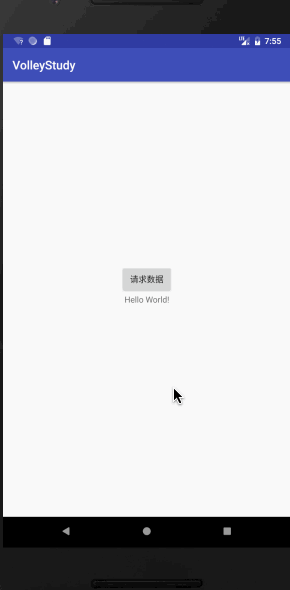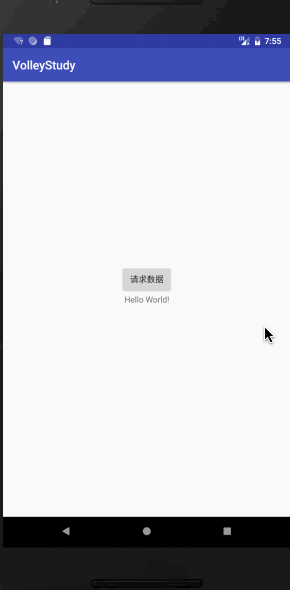Volley、Okhttp、Retrofit的基本使用,使用GET请求String、Json、JsonArray+使用POST传递数据
目录
- 简介
- Volley篇
- 一、请求String
- 1.1.效果图
- 1.2.代码实现
- 1.在app模块的build.gradle的dependencies中引入Volley
- 2.在AndroidManifest中添加网络权限
- 3.创建一个RequestQueue对象
- 4. 创建一个StringRequest对象
- 5. 将StringRequest对象添加到RequestQueue里。
- MainActivity的完整代码
- 二、请求Json
- 2.1.效果图
- 2.2.代码实现
- 三、请求JsonArray
- 3.1.效果图
- 3.2.代码实现
- 四、POST数据
- 源码已上传
- Okhttp篇
- 1.在app模块的build.gradle的dependencies中引入Okhttp
- 2.在AndroidManifest中添加网络权限
- 3.发送Get请求
- 4.发送Post请求
- Retrofit篇
- 1.在app模块的build.gradle的dependencies中引入Retrofit
- 2.在AndroidManifest中添加网络权限
- 3.发送Get请求
- 4.发送Post 请求
- 5.Retrofit结合Gson,返回指定类型对象
简介
Volley、Okhttp、Retrofit都是用于发送和接收网络数据的框架。可以使用其进行GET请求和POST请求。本篇讲解通过GET方法请求String、Json、JsonArray,以及通过POST方法发送数据。
Volley篇
Volley的Github 地址:https://github.com/google/volley
一、请求String
1.1.效果图
1.2.代码实现
1.在app模块的build.gradle的dependencies中引入Volley
implementation 'com.android.volley:volley:1.1.0'
2.在AndroidManifest中添加网络权限
<uses-permission android:name="android.permission.INTERNET" />
3.创建一个RequestQueue对象
RequestQueue mQueue = Volley.newRequestQueue(this);
4. 创建一个StringRequest对象
StringRequest stringRequest = new StringRequest("https://wkxjc.github.io/test_string.txt",
new Response.Listener<String>() {
@Override
public void onResponse(final String response) {
textView.post(new Runnable() {
@Override
public void run() {
textView.setText(response);
}
});
}
}, null);
StringRequest(String url, Listener listener, ErrorListener errorListener)参数说明:
(1)String url 请求的URL地址
(2)Listener listener 请求成功的回调,在onResponse(String response)中的response就是请求到的数据。
这里把请求到的数据显示到了textView里面,由于在子线程中不能更新UI,所以使用了post方法更新UI,原理和使用Handler相同。
(3)ErrorListener errorListener 请求失败的回调
5. 将StringRequest对象添加到RequestQueue里。
mQueue.add(stringRequest);
MainActivity的完整代码
public class MainActivity extends AppCompatActivity {
private Button button;
private TextView textView;
@Override
protected void onCreate(Bundle savedInstanceState) {
super.onCreate(savedInstanceState);
setContentView(R.layout.activity_main);
button = findViewById(R.id.button);
textView = findViewById(R.id.text);
requestString();//Volley请求String
}
private void requestString() {
button.setOnClickListener(new View.OnClickListener() {
@Override
public void onClick(View v) {
RequestQueue mQueue = Volley.newRequestQueue(MainActivity.this);
StringRequest stringRequest = new StringRequest("https://wkxjc.github.io/test_string.txt",
new Response.Listener<String>() {
@Override
public void onResponse(final String response) {
textView.post(new Runnable() {
@Override
public void run() {
textView.setText(response);
}
});
}
}, null);
mQueue.add(stringRequest);
}
});
}
}
这就是Volley的通过GET获取String的方法。
二、请求Json
2.1.效果图
2.2.代码实现
1,2,3,5步和 一、请求String 完全一样,只有第四步的StringRequest变成了JsonObjectRequest
JsonObjectRequest jsonObjectRequest = new JsonObjectRequest("https://wkxjc.github.io/test_json.json",
null, new Response.Listener<JSONObject>() {
@Override
public void onResponse(final JSONObject response) {
textView.post(new Runnable() {
@Override
public void run() {
textView.setText(response.toString());
}
});
}
}, null);
完整代码为:
public class MainActivity extends AppCompatActivity {
private Button button;
private TextView textView;
@Override
protected void onCreate(Bundle savedInstanceState) {
super.onCreate(savedInstanceState);
setContentView(R.layout.activity_main);
button = findViewById(R.id.button);
textView = findViewById(R.id.text);
requestJson();//Volley请求Json
}
private void requestJson() {
button.setOnClickListener(new View.OnClickListener() {
@Override
public void onClick(View v) {
RequestQueue mQueue = Volley.newRequestQueue(MainActivity.this);
JsonObjectRequest jsonObjectRequest = new JsonObjectRequest("https://wkxjc.github.io/test_json.json",
null, new Response.Listener<JSONObject>() {
@Override
public void onResponse(final JSONObject response) {
textView.post(new Runnable() {
@Override
public void run() {
textView.setText(response.toString());
}
});
}
}, null);
mQueue.add(jsonObjectRequest);
}
});
}
}
三、请求JsonArray
3.1.效果图
3.2.代码实现
1,2,3,5步和 一、请求String 完全一样,只有第四步的StringRequest变成了JsonArrayRequest
JsonArrayRequest jsonArrayRequest = new JsonArrayRequest("https://wkxjc.github.io/test_json_array.json",
new Response.Listener<JSONArray>() {
@Override
public void onResponse(final JSONArray response) {
textView.post(new Runnable() {
@Override
public void run() {
textView.setText(response.toString());
}
});
}
},null);
完整代码为:
public class MainActivity extends AppCompatActivity {
private Button button;
private TextView textView;
@Override
protected void onCreate(Bundle savedInstanceState) {
super.onCreate(savedInstanceState);
setContentView(R.layout.activity_main);
button = findViewById(R.id.button);
textView = findViewById(R.id.text);
requestJsonArray();//Volley请求JsonArray
}
private void requestJsonArray() {
button.setOnClickListener(new View.OnClickListener() {
@Override
public void onClick(View v) {
RequestQueue mQueue = Volley.newRequestQueue(MainActivity.this);
JsonArrayRequest jsonArrayRequest = new JsonArrayRequest("https://wkxjc.github.io/test_json_array.json",
new Response.Listener<JSONArray>() {
@Override
public void onResponse(final JSONArray response) {
textView.post(new Runnable() {
@Override
public void run() {
textView.setText(response.toString());
}
});
}
},null);
mQueue.add(jsonArrayRequest);
}
});
}
}
四、POST数据
代码实现:
1,2,3,5步和 一、请求String 完全一样,只有第四步,先把Request的第一个参数设置为Request.Method.POST,再在StringRequest的匿名类中重写getParams()方法,在这里设置POST参数。
StringRequest stringRequest = new StringRequest(Request.Method.POST, "https://wkxjc.github.io/test_post.txt",
new Response.Listener<String>() {
@Override
public void onResponse(final String response) {
textView.post(new Runnable() {
@Override
public void run() {
textView.setText(response);
}
});
}
}, null) {
@Override
protected Map<String, String> getParams() throws AuthFailureError {
Map<String, String> map = new HashMap<>();
map.put("params1", "value1");
map.put("params2", "value2");
return map;
}
};
完整代码:
public class MainActivity extends AppCompatActivity {
private Button button;
private TextView textView;
@Override
protected void onCreate(Bundle savedInstanceState) {
super.onCreate(savedInstanceState);
setContentView(R.layout.activity_main);
button = findViewById(R.id.button);
textView = findViewById(R.id.text);
requestStringPOST();//Volley POST数据
}
private void requestStringPOST() {
button.setOnClickListener(new View.OnClickListener() {
@Override
public void onClick(View v) {
RequestQueue mQueue = Volley.newRequestQueue(MainActivity.this);
StringRequest stringRequest = new StringRequest(Request.Method.POST, "https://wkxjc.github.io/test_post.txt",
new Response.Listener<String>() {
@Override
public void onResponse(final String response) {
textView.post(new Runnable() {
@Override
public void run() {
textView.setText(response);
}
});
}
}, null) {
@Override
protected Map<String, String> getParams() throws AuthFailureError {
Map<String, String> map = new HashMap<>();
map.put("params1", "value1");
map.put("params2", "value2");
return map;
}
};
mQueue.add(stringRequest);
}
});
}
}
以上,就是Volley的基本用法:使用GET请求String、Json、JsonArray+使用POST传递数据
源码已上传
https://github.com/wkxjc/VolleyStudy
Okhttp篇
Okhttp的Github地址为:https://github.com/square/okhttp
1.在app模块的build.gradle的dependencies中引入Okhttp
implementation 'com.squareup.okhttp3:okhttp:3.10.0'
2.在AndroidManifest中添加网络权限
3.发送Get请求
OkHttpClient client = new OkHttpClient();
Request request = new Request.Builder()
.url("https://wkxjc.github.io/test_json_fixed.json")
.build();
client.newCall(request).enqueue(new Callback() {
@Override
public void onFailure(Call call, IOException e) {
}
@Override
public void onResponse(Call call, Response response) throws IOException {
final String strResponse = response.body().string();
runOnUiThread(new Runnable() {
@Override
public void run() {
text.setText(strResponse);
}
});
}
});
在enqueue中传入Callback,网络请求会异步执行,执行完后运行Callback中的回调方法onResponse或者onFailure
4.发送Post请求
OkHttpClient client = new OkHttpClient();
FormBody formBody = new FormBody.Builder()
.add("params1","value1")
.add("params2","value2")
.build();
Request request = new Request.Builder()
.url("https://wkxjc.github.io/test_post.txt")
.post(formBody)
.build();
client.newCall(request).enqueue(new Callback() {
@Override
public void onFailure(Call call, IOException e) {
}
@Override
public void onResponse(Call call, Response response) throws IOException {
final String strResponse = response.body().string();
runOnUiThread(new Runnable() {
@Override
public void run() {
text.setText(strResponse);
}
});
}
});
将需要post的参数封装在FormBody中,在新建request对象时,使用Builder().post方法传入formBody,之后的步骤和Get请求一样,在enqueue中传入Callback,网络请求会异步执行,执行完后运行Callback中的回调方法onResponse或者onFailure
Retrofit篇
Retrofit的Github地址为:https://github.com/square/retrofit
1.在app模块的build.gradle的dependencies中引入Retrofit
implementation 'com.squareup.retrofit2:retrofit:2.4.0'
2.在AndroidManifest中添加网络权限
<uses-permission android:name="android.permission.INTERNET" />
3.发送Get请求
Retrofit是使用注解的方式区分Get和Post的,首先新建一个接口文件IWebUtil:
public interface IWebUtil {
@GET("test_json_fixed.json")
Call<ResponseBody> getInfo();
}
在程序中使用:
Retrofit retrofit = new Retrofit.Builder()
.baseUrl("https://wkxjc.github.io/")
.build();
IWebUtil util = retrofit.create(IWebUtil.class);
Call<ResponseBody> call = util.getInfo();
call.enqueue(new Callback<ResponseBody>() {
@Override
public void onResponse(Call<ResponseBody> call, Response<ResponseBody> response) {
try {
text.setText(response.body().string());
} catch (IOException e) {
e.printStackTrace();
}
}
@Override
public void onFailure(Call<ResponseBody> call, Throwable t) {
}
});
创建Retrofit对象的时候,传入了一个baseUrl,这个baseUrl规范是以’/'结尾,它和注解中括号内的字符串将组成网络请求的url。
在enqueue中传入Callback,网络请求会异步执行,执行完后运行Callback中的回调方法onResponse或者onFailure。这点和Okhttp一样,因为Retrofit内部就是通过Okhttp实现的。Retrofit只是将Okhttp封装了一下而已。不过Retrofit还帮我们做了一件事情,就是将onResponse和onFailure函数切换到了主线程执行。
4.发送Post 请求
前面已经说到,Retrofit是用注解区分GET和POST请求的,所以同样的,我们在接口中加入@POST注解
public interface IWebUtil {
@POST("test_post.text")
@FormUrlEncoded
Call<ResponseBody> postForm(@FieldMap Map<String,Object> map);
}
在程序中使用:
Retrofit retrofit = new Retrofit.Builder()
.baseUrl("https://wkxjc.github.io/")
.build();
IWebUtil util = retrofit.create(IWebUtil.class);
Map<String,Object> map = new HashMap<>();
map.put("params1","value1");
map.put("params2","value2");
Call<ResponseBody> call = util.postForm(map);
call.enqueue(new Callback<ResponseBody>() {
@Override
public void onResponse(Call<ResponseBody> call, Response<ResponseBody> response) {
try {
text.setText(response.body().string());
}
} catch (IOException e) {
e.printStackTrace();
}
}
@Override
public void onFailure(Call<ResponseBody> call, Throwable t) {
}
});
将需要post的值封装在HashMap中,使用postForm将这个HashMap传入即可。之后的步骤和Get请求一样,在enqueue中传入Callback,网络请求会异步执行,执行完后运行Callback中的回调方法onResponse或者onFailure。onResponse和onFailure同样是在主线程中执行的。
以上就是Retrofit的Get和Post方法的基本使用。以上方法的callback中,都是返回responseBody对象,拿到这个对象我们就可以解析了。Retrofit还可以与解析json的框架结合使用,下面介绍retrofit和gson结合使用解析json字符串。
5.Retrofit结合Gson,返回指定类型对象
Retrofit和Gson结合使用非常简单,只需要在构建Retrofit对象时增加一句 addConverterFactory(GsonConverterFactory.create()) ,我们就可以将Callback中返回的ResponseBody改成自己需要的格式了。不过要使用Gson,先要在app的build.gradle中导入Retrofit和Gson结合的包
implementation 'com.squareup.retrofit2:converter-gson:2.4.0'
本例中,通过 https://wkxjc.github.io/test_json.json 这个网址获取一段json字符串,字符串结构为:
{"id":"1","name":"name_one","age":"11"}
根据此结构,先创建Message对象:
public class Message {
private String id;
private String name;
private String age;
public String getId() {
return id;
}
public void setId(String id) {
this.id = id;
}
public String getName() {
return name;
}
public void setName(String name) {
this.name = name;
}
public String getAge() {
return age;
}
public void setAge(String age) {
this.age = age;
}
}
IWebUtil中的GET方法:
public interface IWebUtil {
@GET("test_json.json")
Call<Message> getInfo();
}
程序中调用:
Retrofit retrofit = new Retrofit.Builder()
.baseUrl("https://wkxjc.github.io/")
.addConverterFactory(GsonConverterFactory.create())
.build();
IWebUtil util = retrofit.create(IWebUtil.class);
Call<Message> call = util.getInfo();
call.enqueue(new Callback<Message>() {
@Override
public void onResponse(Call<Message> call, Response<Message> response) {
Message message = response.body();
if (message!= null) {
text.setText(message.getName());
}
}
@Override
public void onFailure(Call<Message> call, Throwable t) {
}
});
Retrofit就是这么简单。Retrofit和Rxjava现在非常的火,使用也很广泛。很多人都不知道怎么下手,或者是有畏难情绪。包括笔者之前也一直嫌Retrofit注解麻烦,学习之后发现Retrofit的注解帮我们使用网络请求省去了很多操作。其实这些流行的库并不难,毕竟它们都是为了程序员更简单的编程而诞生的。后面我会再写一篇Rxjava的文章。

